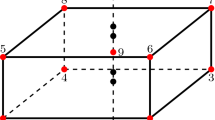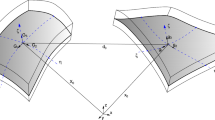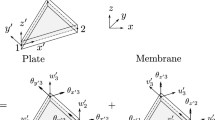Abstract
In this work we derive and mutually compare several 4-node shell hyperelastic finite elements for large deformation analysis. The elements are based on Reissner–Mindlin shell theory. They use the enhanced assumed strain (EAS) concept for enhancement of membrane and bending displacement-compatible strains and the assumed natural strain (ANS) concept for treatment of transverse shear strains. The elements differ from each other by the number of membrane and bending EAS parameters. An optimal number of these parameters is suggested on the basis of numerical results.
Similar content being viewed by others
References
Andelfinger U and Ramm E (1993). EAS—elements for two-dimensional, three-dimensional, plate and shell structures and their equivalence to HR-elements. Int J Numer Meth Eng 36: 1311–1337
Bathe KJ and Dvorkin E (1985). A four-node plate bending element based on Mindlin–Reissner plate theory and a mixed interpolation. Int J Numer Meth Eng 21: 367–383
Başar Y, Itskov M and Eckstein A (2000). Composite laminates: nonlinear interlaminar stress analysis by multi-layer shell elements. Comput Methods Appl Mech Eng 185: 367–397
Betsch P and Stein E (1996). A nonlinear extensible 4-node shell element based on continuum theory and assumed strain interpolations. J Nonlinear Sci 6: 169–199
Betsch P, Gruttmann F and Stein E (1996). A 4-node finite shell element for the implementation of general hyperelastic 3d-elasticity at finite strain. Comput Meth Appl Mech Eng 130: 57–79
Bischoff M and Ramm E (1997). Shear deformable shell elements for large strains and rotations. Comput Meth Appl Mech Eng 40: 4427–4449
Brank B, Perić D and Damjanić FB (1997). On large deformation of thin elasto-plastic shells: implementation of a finite rotation model for quadrilateral shell elements. Int J Numer Meth Eng 40: 689–726
Brank B and Ibrahimbegovic A (2001). On the relation between different parametrizations of finite rotations for shells. Eng Comput 18: 950–973
Brank B, Korelc J and Ibrahimbegovic A (2002). Nonlinear shell problem formulation accounting for through-the-thickness stretching and its finite element implementation. Comput Struc 80: 699–717
Büchter N, Ramm E and Roehl D (1994). Three-dimensional extension of nonlinear shell formulation based on the enhanced assumed strain concept. Int J Numer Meth Eng 37: 2551–2568
Eberlein R and Wriggers P (1999). Finite element concepts for finite elastoplastic strains and isotropic stress response in shells: theoretical and computational analysis. Comput Meth Appl Mech Eng 171: 243–279
Gruttmann F and Wagner W (2006). Structural analysis of composite laminates using a mixed hybrid shell element. Comput Mech 37: 479–497
Ibrahimbegovic A, Brank B and Courtois P (2001). Stress resultant geometrically exact form of classical shell model and vector-like parametrization of constrained finite rotations. Int J Numer Meth Eng 52: 1235–1252
Jabareen M and Rubin MB (2007). Hyperelasticity and physical shear buckling of a block predicted by the Cosserat point element compared with inelasticity and hourglassing predicted by other element formulations. Comput Mech 40: 447–459
Kegl M and Brank B (2006). Shape optimization of truss-stiffened shell structures with variable thickness. Comput Methods Appl Mech Eng 195: 2611–2634
Kegl M, Brank B, Harl B, Oblak MM (2007) Efficient handling of stability problems in shell optimization by asymmetric ‘worst-case’ shape imperfection. Int J Numer Meth Eng. Available online http://dx.doi.org/10.1002/nme.2113
Klinkel S, Gruttmann F and Wagner W (1999). A continuum based three-dimensional shell element for laminated structures. Comput Struc 71: 43–62
Korelc J (1997). Automatic generation of finite element code by simultaneous optimization of expressions. Theor Comput Sci 187: 231–248
Korelc J (2007) AceGen, AceFem. http://www.fgg.uni-lj.si/Symech
Krätzig WB and Jun D (2003). On ‘best’ shell models—from classical shells, degenerated and multilayered concepts to 3D. Arch Appl Mech 73: 1–25
Parisch H (1991). An investigation of a finite rotaion four node assumed strain shell element. Int J Numer Meth Eng 31: 127–150
Sansour C and Kollmann FG (2000). Families of 4-node and 9-node finite elements for a finite deformation shell theory. An assessment of hybrid stress, hybrid strain and enhanced strain elements. Comput Mech 24: 435–447
Simo JC and Rifai S (1990). A class of mixed assumed strain methods and the method of incompatible modes. Int J Numer Meth Eng 29: 1595–1638
Simo JC and Armero F (1992). Geometrically non-linear enhanced strain mixed methods and the method of incompatible modes. Int J Numer Meth Eng 33: 1413–1449
Sze KY, Liu XH and Lo SH (2004). Popular benchmark problems for geometric nonlinear analysis of shells. Finite Elem Anal Des 40: 1551–1569
Vu-Quoc L and Tan XG (2003). Optimal solid shells for non-linear analyses of multilayered composites. I. Statistics. Comput Meth Appl Mech Eng 192: 975–1016
Vu-Quoc L and Tan XG (2003). Optimal solid shells for non-linear analyses of multilayered composites. II. Dynamics. Comput Meth Appl Mech Eng 192: 1017–1059
Zupan D and Saje M (2006). The linearized three-dimensional beam theory of naturally curved and twisted beams: The strain vector formulation. Comput Meth Appl Mech Eng 195: 4557–4578
Author information
Authors and Affiliations
Corresponding author
Rights and permissions
About this article
Cite this article
Brank, B. Assessment of 4-node EAS–ANS shell elements for large deformation analysis. Comput Mech 42, 39–51 (2008). https://doi.org/10.1007/s00466-007-0233-3
Received:
Accepted:
Published:
Issue Date:
DOI: https://doi.org/10.1007/s00466-007-0233-3




